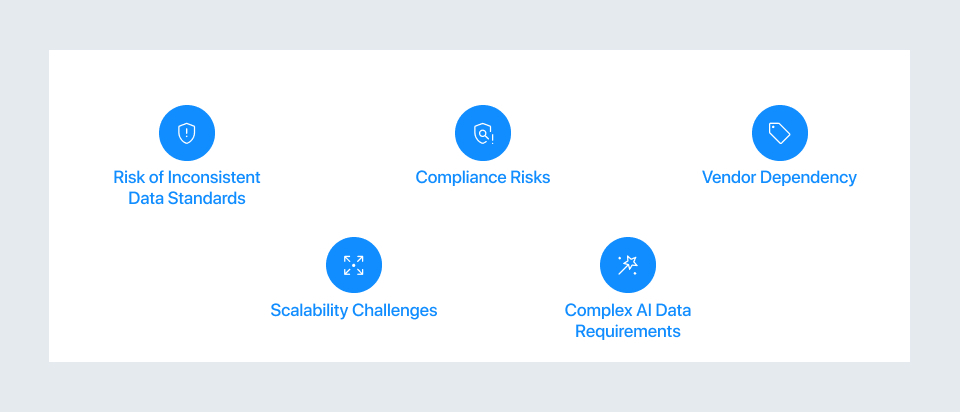Is Your Data Governance Strong Enough to Handle the Deluge?
Data is often hailed as the new oil in today's rapidly evolving digital landscape. It fuels business intelligence, drives analytics, and is essential for meeting stringent compliance requirements. However, harnessing the true power of data isn't as simple as collecting it. Organizations across industries, from manufacturing to retail to finance, face significant challenges in ensuring their data is reliable, accurate, secure, and accessible. Without a structured approach, data can become fragmented, inconsistent, and untrustworthy, hindering decision-making and exposing companies to substantial risks.
This is where a robust Data Governance Framework integrated with effective Data Management Practices becomes beneficial and essential. Keeping up with emerging trends in data governance and leveraging modern data governance tools ensures that data quality, security, and accessibility are maintained while aligning with organizational goals and regulatory standards. By adopting such a framework, businesses can significantly enhance decision-making, streamline operations, and maintain compliance in an increasingly data-dependent world. This guide is intended for business leaders, data teams, and IT decision-makers who are navigating the complexities of data and seeking to unlock its full potential.
At NeenOpal, we understand that effective data strategy and digital transformation hinge on well-governed data. Implementing a comprehensive data framework is key to achieving operational efficiency, regulatory adherence, and competitive advantage.
Why Structured Data Management and Governance Matter
The core purpose of a data governance framework is to ensure the integrity, security, and accessibility of data. It is the backbone for enhancing data-driven decision-making by guaranteeing access to high-quality, trusted data. Furthermore, supporting regulatory compliance with critical frameworks like GDPR, HIPAA, and CCPA is vital, ensuring that organizations avoid costly penalties and reputational damage.
An integrated data management strategy also improves data integrity and consistency across diverse systems and departments. It helps establish clear ownership and accountability for data assets and optimizes data access control and security to protect sensitive information. Managing the data lifecycle efficiently, from collection to deletion, ensures appropriate retention, archiving, and disposal. Finally, it streamlines data cataloging and discoverability, improving accessibility and transparency for all stakeholders.
The framework is designed to cover the entire data lifecycle and can be customized to suit a company's size, industry, and regulatory requirements. Its intended users span various critical organizational roles, including Data Governance Councils, Data Owners, Data Stewards, IT Teams, Business Teams, and Compliance Officers.
Core Elements of a Robust Data Governance Framework

Implementing a practical data governance framework requires focusing on several core elements:
1. Defining Roles, Responsibilities, and Frameworks
Clear roles and responsibilities are fundamental to ensuring data integrity, security, and accessibility.
-
- The Steering Committee/Governance Council provides strategic oversight, aligning governance efforts with business objectives and regulatory compliance.
- Data Owners are responsible for managing specific data sets, enforcing policies, and ensuring the accuracy and security within their domain.
- Data Stewards handle the day-to-day management, maintaining quality standards, supporting policies, and collaborating with business teams.
- Business Teams/Stakeholders use data for decisions, adhere to policies, and provide feedback.
- IT Teams implement the technical tools and platforms.
- Compliance Officers ensure adherence to data privacy laws and security standards.
The RACI model is critical for clearly defining these roles and responsibilities, avoiding confusion, streamlining processes, and ensuring accountability.
-
- Responsible (R): Those performing the task, ensuring it meets required standards (e.g., Data Stewards, Data Analysts).
- Accountable (A): The single person ultimately responsible for the task or decision (e.g., Chief Data Officer, Data Governance Manager).
- Consulted (C): Individuals providing input based on expertise (e.g., IT Security Team, Compliance Officers).
- Informed (I): Stakeholders who need to be updated on progress or decisions (e.g., Business Leaders/Executives, End Users).
Various established frameworks can guide the implementation process:
-
- DGI (Data Governance Institute) Framework: Emphasizes accountability, transparency, and alignment with business strategy. Ideal for building a program from scratch, especially in large, complex organizations. Key features include clearly defined roles, processes, technology integration, and collaboration.
- DAMA DMBOK (Data Management Body of Knowledge) Framework: A comprehensive guide covering 11 knowledge areas, including data governance, quality, and security. It takes a holistic approach, viewing data as a strategic asset and encouraging continuous improvement. Suitable for organizations with mature structures seeking an overarching framework.
- McKinsey Data Governance Framework: Designed for flexibility and scalability, aligning governance practices with evolving business needs and strategy. Promotes a strong data governance culture. Best for growing or transforming companies needing an adaptable approach.
- Maturity Model: A framework for assessing the current state of governance and providing a roadmap for improvement. Defines stages (Initial, Managed, Defined, Quantitatively Managed, Optimized). Useful for incremental improvement and organizations in early stages.
2. Implementing Best Practices for Consistent and Accurate Data Management
Effective data management is crucial for consistency, accuracy, and compliance. Key best practices include:
-
- Policies and Procedures: Establishing data access, usage, and audit rules ensures integrity. Steps include defining Access Control Policies (using systems like Microsoft Azure Active Directory for RBAC), creating Data Usage Guidelines (adhering to standards like ISO 9001), conducting Periodic Audits, and establishing Data Retention and disposal Policies. Outcomes include reduced unauthorized access, improved quality, and streamlined processes.
- Metadata Management: Standardizing data across systems is essential for operational consistency and quality control. This involves Standardizing Formats, implementing Naming Conventions, and using Master Data Management (MDM) tools (like AWS Glue, Azure Purview) to create a single source of truth. Expected outcomes are reduced errors, improved timelines, and easier integration. Effective metadata management enables traceability and quality control, requiring Cataloging Metadata, Automating Metadata Collection, and Protecting Metadata with encryption and access control. Tools like AWS Glue Data Catalog, Azure Purview, AWS KMS, and Azure Key Vault are relevant.
As illustrated in the NeenOpal case study on enhancing metadata checks for content discoverability, standardizing metadata benchmarks and implementing logical validation layers ensure consistent, high-quality metadata across systems, paralleling the data catalog and metadata management approaches outlined in this guide.
- Data Quality Standards: Ensuring data is accurate and fit for use is paramount.
- Lifecycle Management: Managing data from creation to deletion is critical for efficiency and compliance. Steps include Data Acquisition from reliable sources, Secure Storage using encrypted and redundant solutions (like AWS, Microsoft Azure, Amazon S3 Glacier, Azure Blob Storage), Monitoring Data Usage to ensure privacy compliance, developing Archival Systems for historical data, and securely decommissioning obsolete data. Outcomes include streamlined access, compliance, and secure handling of sensitive data.
- Modern Enhancements: Utilizing modern tools enhances governance through scalability, automation, and real-time insights. This involves Adopting Cloud Platforms (AWS, Azure), implementing Data Virtualization tools, leveraging AI/ML (TensorFlow) for predictive analytics, and utilizing Real-Time Monitoring systems. Expected outcomes are enhanced decision-making, increased efficiency, and better forecasting.
- Monitoring and Adaptability: Continuous monitoring ensures governance aligns with business goals and evolving technology. This includes changing KPIs (tracked with tools like Power BI and Tableau), implementing Feedback Mechanisms (using systems like AWS SQS and Azure Logic Apps), adopting Scalable Solutions, and providing Continuous Training. Outcomes include evolving practices, increased employee engagement, and scalable tools.
3. Implementing Version Control and Logging Practices
Version Control is necessary to track, document, and recover data-related changes, facilitate collaboration, and prevent data loss. Key principles include using a Centralized Repository (like Git, GitLab, GitHub, Azure DevOps) for tracking changes, applying Semantic Versioning, implementing a Branching Strategy, enforcing Access Control with role-based permissions, and ensuring Change Documentation with clear messages. Best practices include creating baselines, auditing histories, ensuring backward compatibility, and aligning strategies with business needs. Relevant tools include Database Versioning Tools like AWS DMS and Azure Data Studio, and Collaborative Platforms like AWS Chime, Azure DevOps, Jira, and Confluence.
Logging Practices are essential for tracking events, changes, and anomalies, supporting troubleshooting, and ensuring an audit trail for compliance. Types of logs include Access Logs, Change Logs, Error Logs, and Audit Logs. Key elements involve Granular Logging, Timestamp Synchronization, defining a Log Retention Policy based on regulations (e.g., GDPR), Anonymization and Masking of sensitive data, and Real-Time Monitoring using tools like AWS CloudWatch or Azure Monitor. Implementation involves Automated Alerts, Log Aggregation, Regular Audits, and Encryption and Security of log files. Challenges like high storage costs, log overload, and integration issues can be mitigated through practices like log rotation/compression, filtering, and standardizing formats.
4. Developing Necessary Training Programs
Training programs ensure all stakeholders understand and effectively implement data governance practices. The key objectives are to develop necessary skills, promote awareness of roles and compliance, standardize processes, and equip teams with tools. Core topics should cover data governance fundamentals, roles and responsibilities, data standards and policies (quality, metadata, lifecycle, security), governance tools (AWS Glue, Azure Purview), version control tools (AWS CodeCommit, Azure Repos, AWS DMS), logging tools (AWS CloudWatch, Azure Monitor), compliance and risk mitigation, and change/version control practices.
Delivery methods can include Instructor-Led Training, Self-Paced Learning, On-the-Job Training, Role-Based Training, and Cross-Functional Knowledge Sharing. Effectiveness can be measured through assessments, feedback mechanisms, performance metrics (like error reduction or compliance adherence), periodic refresher courses, and behavioral observation.
Practical Examples in Action
Let's look at how integrating data and analytics governance and management practices addresses common business challenges:
-
- Addressing Inconsistent Data Architecture: A company struggling with fragmented data systems across factories, using different formats and metrics (e.g., inventory by weight vs. quantity), faced confusion and delays. By adopting a data governance and analytics strategy along with a centralized data management system, they created a single shared repository, established uniform standards for tracking, gained real-time visibility, and streamlined processes. Technologies used included data governance tools (AWS Glue Data Catalog, Azure Purview), integration platforms (Apache Kafka), data warehouses (Snowflake, Azure Synapse), visualization tools (Power BI, Tableau), and IoT solutions (AWS IoT Core, Azure IoT Hub). This improved collaboration and reduced downtime.
- Data Catalog for Transparency and Discoverability: An organization with data dispersed across multiple teams and systems struggled to find and use critical datasets, leading to duplicated effort and reliance on outdated information. Implementing a centralized data catalog provided a searchable inventory with metadata, descriptions, and ownership, enabling better collaboration and faster, more informed decisions. Data trustworthiness was improved through quality checks and lineage tracking. Tools included data catalog tools (AWS Glue Data Catalog, Azure Purview), data governance solutions (Azure Purview, AWS Lake Formation), integration tools (Apache Kafka), data storage (Snowflake, Azure Data Lake, AWS S3), and search/visualization tools (Elasticsearch, Power BI, Tableau).
- Centralized Logging for Data Access: A company struggled to track data access across various systems, especially for sensitive PII, creating potential risks. Implementing a centralized logging system created a single source of truth for access events, enabling quick identification of unauthorized access and simplified audit processes for compliance. This enhanced data security, streamlined compliance, and increased control over data access. Technologies leveraged included centralized logging tools (AWS CloudWatch Logs, Azure Monitor Logs, ELK Stack), Access Control Integration (AWS IAM, Azure Active Directory), Data Governance Systems (AWS Lake Formation, Azure Purview), and Cloud Logging Solutions (AWS CloudTrail, Azure Monitor).
-
- Metadata Versioning for Data Schema Changes: Frequent updates to a customer database caused issues for downstream systems due to untracked schema changes. Implementing metadata versioning maintained a clear history of changes, enabling teams to adapt systems smoothly before deployment, reducing downtime and errors. This improved reliability and ensured seamless updates. Tools included metadata management tools (AWS Glue Data Catalog, Azure Purview), Version Control Systems (Apache Atlas, AWS Glue Schema Registry), Data Integration Tools (AWS Data Pipeline, Azure Data Factory, Apache NiFi), and modern databases supporting schema evolution (Snowflake, Azure Synapse Analytics, Amazon Redshift).
Addressing Potential Cautions

While the benefits are clear, organizations must also be aware of potential challenges:
-
- Risk of Inconsistent Data Standards: Mitigation involves developing enterprise-wide guidelines, assigning Data Stewardship roles, and providing training. A real-life example showed how inconsistent product codes hindered reporting for a retail chain.
- Compliance Risks: Mitigated by regular audits, staying updated on regulations, and implementing data protection policies. A technology company faced a fine for insufficient transparency, highlighting the need for audits and clear consent.
- Vendor Dependency: Addressed by opting for vendor-neutral solutions, diversifying reliance, and establishing exit strategies. A media company used a multi-cloud strategy to avoid downtime faced with a single vendor outage.
- Scalability Challenges: Addressed through scalable data architecture (cloud-based, distributed), performance monitoring, and capacity planning. A streaming platform migrated to a scalable cloud infrastructure to handle user growth.
- Complex AI Data Requirements: Mitigated by implementing data governance for AI inputs (validation, diversity), bias detection, transparent documentation, and output monitoring. A recruitment platform improved fairness by using diverse and unbiased datasets.
Addressing these cautions proactively is key to building a robust Data Governance Framework that ensures compliance, reliability, and scalability while supporting advanced analytics and AI initiatives.
Conclusion
Organizations face a data deluge in the era of big data and digital transformation that can overwhelm traditional systems. Effective analytics data governance and integrated data management are no longer optional but foundational for success. Implementing a structured framework with strong data analytics governance ensures your data is a trustworthy asset, enabling informed decisions, efficient operations, and seamless compliance. Organizations can transform their data into a powerful strategic advantage by establishing clear roles, implementing best practices for data quality, metadata, access control, and lifecycle management, and leveraging modern tools.
Ready to unlock the full potential of your data?
NeenOpal specializes in helping organizations like yours build and implement comprehensive Data Governance Frameworks and integrated Data Management Strategies. Our expertise in data consulting and digital transformation can guide you every step of the way.
Contact us today for a consultation or explore our data management solutions to learn how we can help you navigate the data landscape with confidence.
Frequently Asked Questions
1. What is data governance, and why is it important for businesses?
Data governance is the framework that ensures data accuracy, security, and accessibility across an organization. It helps businesses improve decision-making, comply with regulations like GDPR and HIPAA, and maintain data quality. Without data governance, organizations risk data silos, compliance penalties, and unreliable insights.
2. How does a data governance framework improve data management and compliance?
A robust data governance framework standardizes processes, assigns accountability, and secures sensitive information. By implementing data quality controls, metadata management, and lifecycle policies, companies can ensure reliable data for analytics while meeting compliance requirements in industries like finance, healthcare, and retail.
3. What best practices should organizations follow when implementing a data governance framework?
Businesses should define clear roles (data owners, stewards, compliance officers), adopt modern tools like Azure Purview or AWS Glue, and implement policies for access control, versioning, and logging. Regular audits, training programs, and scalable cloud solutions also ensure long-term success in managing enterprise data governance.






